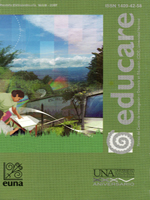Las Artes Plásticas como medio articulador del currículo escolar
DOI:
https://doi.org/10.15359/ree.2-Ext.10Keywords:
plastic art, children's art, creativity, educationAbstract
This article recounts a teacher's experience who integrates the curriculum, through the correlation of elements of plastic art with other subjects such as Math, Science, Social Studies and Spanish. This experience was developed in a Costa Rican rural school.
References
Anzorena, H. ( 1998). Ver para comprender: educación desde el arte. Buenos Aires,
Argentina: Editorial Magisterio del Río de la Plata.
Jacques, D. (1996). La educación encierra un tesoro. México D. F.: UNESCO.
Ministerio de Educación Pública. (2005). Plan de Estudios para las Artes Plásticas
en 1 y JI ciclos. San José, Costa Rica.
Piaget, J. (1993). Psicología del niño. Madrid: Ediciones Morata.
Vega, Roberto. (1996). Escuela, teatro y construcción del conocimiento. Buenos
Aires, Argentina: Ediciones Santillana.
Published
How to Cite
Issue
Section
License
1. In case the submitted paper is accepted for publication, the author(s) FREELY, COSTLESS, EXCLUSIVELY AND FOR AN INDEFINITE TERM transfer copyrights and patrimonial rights to Universidad Nacional (UNA, Costa Rica). For more details check the Originality Statement and Copyright Transfer Agreement
2. REUTILIZATION RIGHTS: UNA authorizes authors to use, for any purpose (among them selfarchiving or autoarchiving) and to publish in the Internet in any electronic site, the paper´'s final version, both approved and published (post print), as long as it is done with a non commercial purpose, does not generate derivates without previous consentment and recognizes both publisher's name and authorship.
3. The submission and possible publication of the paper in the Educare Electronic Journal is ruled by the Journal’s editorial policies, the institutional rules of Universidad Nacional and the laws of the Republic of Costa Rica. Additionally, any possible difference of opinion or future dispute shall be settled in accordance with the mechanisms of Alternative Dispute Resolution and the Costa Rican Jurisdiction.
4. In all cases, it is understood that the opinions issued are those of the authors and do not necessarily reflect the position and opinion of Educare, CIDE or Universidad Nacional, Costa Rica. It is also understood that, in the exercise of academic freedom, the authors have carried out a rogorous scientific-academic process of research, reflection and argumentation thar lays within the thematic scope of interest of the Journal.
5. The papers published by Educare Electronic Journal use a Creative Commons License:














 The articles published by Educare Electronic Journal can be shared with a Creative Commons License:
The articles published by Educare Electronic Journal can be shared with a Creative Commons License: 



